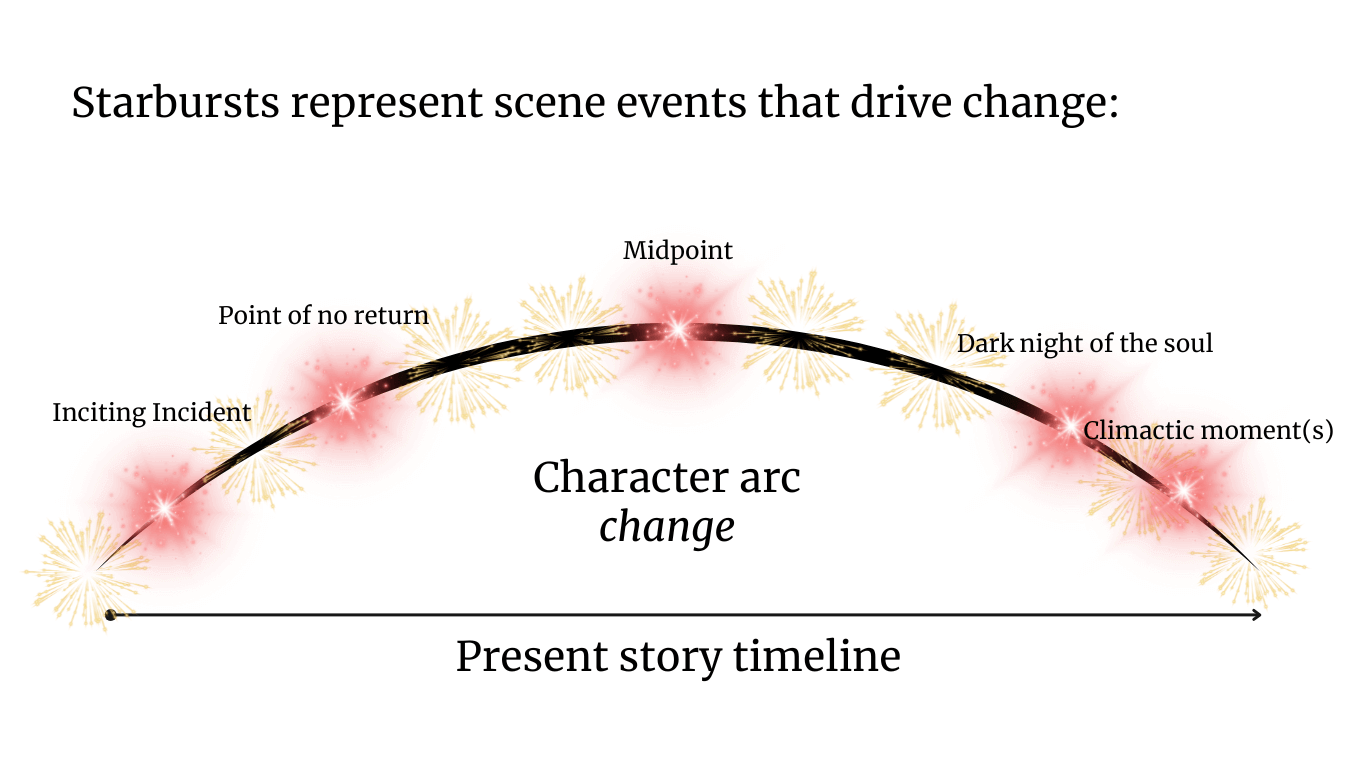WHAT IS THE CLIMACTIC MOMENT?
Your book will have many pivotal moments, big and small, but “the Climactic Moment” refers to an archetypal plot point leveraged in many popular books.
The Climactic Moment is one of five major archetypal turning points that include:
The Inciting Incident: The event that sets up main character(s) for their journey.
The event incites curiosity (in the reader) about whether the main character will meet their story goal. The Inciting Incident often occurs within the first 10%-12% of your pages.
The Point of No Return: The event in which the character commits to the story “adventure” or story conflict, about 25% into your pages.
This turning point pushes the character out of their “normal” or comfortable world, the world in which they act unconsciously on their wound, or the “lie” they believe because of their wound.
Midpoint: The character begins to question their “lie.”
The midpoint (right around 50% of your pages) is sometimes called the “mirror moment.” In some traditional stories, the main character literally looks in a mirror and questions (specifically related to their particular story events): Who am I? How did I get here? Where am I going?
By this point, the main character has gotten a glimmer of truth that opposes their lie, and they begin to act on a new (if incomplete) understanding, rather than continue to react in ways that reinforce their lie/wound.
Dark Night of the Soul: Also referred to as the “all is lost moment.” This is the lowest point in the story for the main character.
At around 75% into your pages, the main character experiences a back slide event where they feel like they’ve failed.
The antagonist (or antagonistic force, often the personification of the wound/lie) seems to have won. This event forces the main character to both fully confront the antagonist and story events so far.
The Climactic Moment(s): These are often a series of story events that take place in the final 85%-98% of your pages.
The main point of climactic story events is to have your main character embrace a new truth/perspective they learned as a direct result of previous story events and act on this new truth/perspective.
Here’s a visual representation that includes Character Arc, Present Story Timeline and Story Drive. (Check out my post on the Three Pillars of Structure)

Story Drive is created by story events that move the character arc forward on a determined timeline. Plot turning points are a part of Story Drive.
Archetypal turning points (Inciting Incident; Point of no return; Midpoint; Dark night of the soul; Climactic moment(s)) provide helpful guidelines for how to express the impact certain story events have on the main character, in a way that develops theme and universal resonance in your book.
Your story already has the potential for these moments, regardless of subject matter. Don’t be thrown off by “battle” language of adventure, conflict and antagonists.
You don’t necessarily need to change the exterior (plot) circumstances of your novel or memoir, instead, deepen the impact of story events by mining them for meaning along these archetypal guidelines.
Here’s the secret: Any external story event can evoke these archetypal moments for your main character.
Every genre of writer, from Romance to Literary Fiction, leverages subtle (sometimes not so subtle) language to evoke these turning points on their characters’ journey to transformation.
WORK BACK FROM THE CLIMACTIC MOMENT
In your book, the Climactic Moment(s) are the pay off for your character, who went through the trials and tribulations of their story in order to have the opportunity to act (differently) in these moments. The Climactic Moment(s) are also pay off for the reader!
It’s hard work to structure a string of story events that build to a new way of thinking/believing/acting for the main character, especially if you, as the author, aren’t certain what the crux of the “truth” is for your character.
So, try working backwards.
- Who is your main character by the end of your novel (or memoir?)
- How have they changed?
- What can they do or express now that would have seemed impossible for them at the beginning of the book?
Once you begin to have a sense of your character (and what they need to do or say) near the end of your book, you can begin to “string together” story events that build to that point.
Think about a book that moved you. Most likely, the moving scene(s) would not be as impactful if they were read out of context.
Scenes derive power from harmony and resonance with other scenes. In beginning drafts, you’re searching for the harmony of your story events.
Exploring climactic scenes can help develop a stronger sense of how your story builds, and where you want to go as you write.




0 Comments